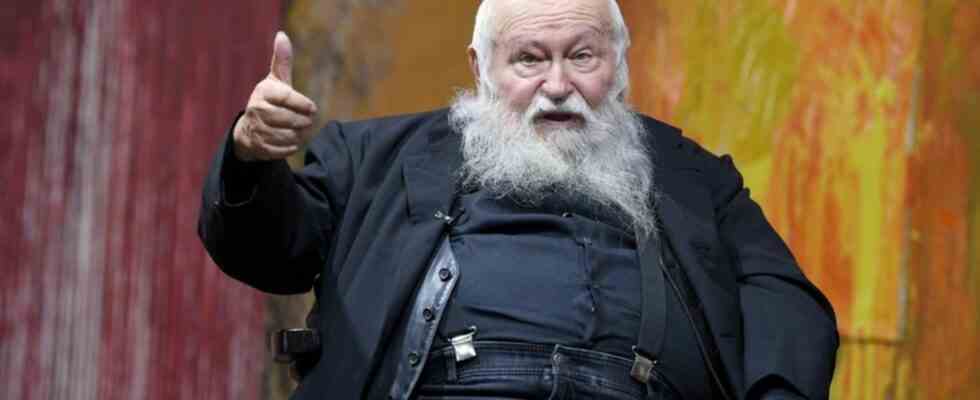actionist
Art between blood and intestines: Hermann Nitsch is dead
The artist Hermann Nitsch died at the age of 83. Photo: Roland Schlager/APA/dpa
© dpa-infocom GmbH
Hardly any artist in Austria has polarized in such a way: Hermann Nitsch’s bloody work with cadavers left no one cold. His controversial art also had many opponents – from animal rights activists to Wagner fans.
Blindfolded, naked people are tied to a wooden cross and rubbed with animal carcasses and intestines. They are repeatedly infused with blood, accompanied by the depressing tones of a brass band.
The images of the archaic actions of the Austrian artist Hermann Nitsch are burned in for everyone who has seen them. The Viennese were both revered and opposed for their extreme rituals. The action artist, painter and sculptor died on Monday at the age of 83 in a hospital in Mistelbach, near his palace north of Vienna.
people’s idea of salvation
The painter with the bushy white beard always wanted to offer people intense experiences for all the senses. Today’s society would repress too much with the help of religion, which would only lead to neuroses. His self-created “orgy-mystery theater”, which he saw as a contemporary continuation of people’s idea of salvation, was intended to remedy the situation. These often day-long actions with animal slaughter, processions and bloodshed actions actually demanded full attention and a strong stomach from participants and spectators alike. “Overcoming the disgust barrier is the task of art,” he told the German Press Agency before his 80th birthday.
A “six-day game” at his castle in 1998 was the current highlight of his work. Based on the 1,700-page ideal score he wrote himself, Nitsch and his “disciples” celebrated a six-day orgiastic happening with music and 13,000 liters of wine. Hundreds of liters of blood were spilled, kilos of grapes and tomatoes were crushed and numerous animal carcasses were gutted.
accepted protests
Nitsch’s actions were controversial. Around 14,000 people signed a petition in 2017 against a planned performance with a freshly slaughtered bull in Tasmania, Australia. Nitsch, on the other hand, regarded dead animals as sacred. “The meat that I use is not eaten, but used for a theatrical performance, i.e. for a higher purpose,” he explained in 2015 after protests against one of his exhibitions.
Nitsch, who was born in Vienna, began working as a commercial artist in the Austrian capital at the end of the 1950s, but he soon founded so-called Viennese Actionism in the early 1960s with artists such as Günther Brus and Otto Muehl. Her performance art, which broke taboos, triggered violent reactions from the public, the media and the authorities.
Imprisoned by the police, ostracized by the church, insulted by animal rights activists: nevertheless, Nitsch never changed the way he worked. Conversely, the attitude of established society towards the eccentric artist changed around the turn of the millennium. Renowned houses show his work, and two museums in Mistelbach and Naples have borne his name for around 15 years.
Booed in Bayreuth
In the venerable Burgtheater in Vienna, Nitsch was allowed to splash with blood during an action in 2005, although the seats and walls were previously covered with plastic. Last year, a painting action followed on the open stage at the Bayreuth Festival as part of a semi-staged production of Richard Wagner’s “Valkyrie”. “Categories like conservative and modern don’t exist for me. For me there is only good work and intensive art, »he told the dpa before the performance, which was sometimes violently booed. Music was an important inspiration for all his work. Nitsch himself wrote countless compositions for his Orgies-Mysteries-Theater.
Despite or precisely because of his death, a long-planned “six-day game” is to be performed at least partially in July. “We promised him that,” his wife Rita Nitsch told the Austrian press agency APA.

